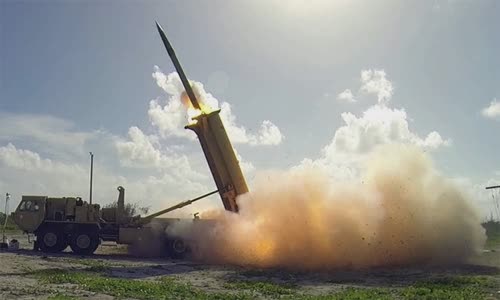The Chinese Air Force has launched a video of missile launch at a target similar to the US base in Guam, but in reality, it is difficult to overcome the defenses here.
The Chinese Air Force on September 19 published a video on social media showing the H-6K bombers rehearsing a simulated air strike on an enemy naval base.

The THAAD complex's interceptor missile left the launch pad at Wake Island during a test, November 2015 Photo: MDA
A source close to the Chinese military's media unit (PLA) said the country's air force video "borrowed" some of the scenes from two Hollywood action movies to make their products "more arresting.
"The video is intended to warn Americans that even supposed safe locations, in the backyard like Guam, could be threatened when there is a flash conflict in the area," said Collin Koh, a family member.
The US naval commanders in charge of forces in the Indo-Pacific also predicted that the US base on Guam would be one of the first targets to be hit if a conflict broke out with China.
"The Chinese military can launch cruise and ballistic missiles against US territorial waters. They can wipe out the main US air base in the Pacific with bombers and aircraft.
This is a modal window.
Beginning of dialog window.
End of dialog window.
Guam Island is located in the middle of the Pacific Ocean, about 2,900 km from China to the southeast.
Andersen Air Base on Guam has a large area with a long runway and a large parking lot that can hold hundreds of aircraft.
The Chinese Missile Forces possess the DF-26 ballistic missile with a range of about 4,000 km, which can reach Guam.
It is not clear how many of these missiles China owns.
However, the US commanders maintained that when a major conflict broke out, there would be several missiles aimed at Guam.
The threat caused the US Army to deploy a Terminal High Altitude Defense System (THAAD) to protect strategically important targets in Guam.
The THAAD and Patriot are both defensive systems that target enemy missiles as they are in the late stages of flight, before the warhead enters into the orbital position.
SM-3 can be launched from destroyers or cruisers possessing the Aegis system with ballistic missile defense.
The Aegis / Aegis Ashore system's AN / SPY-1D passive electronically scanned array radar can detect and track a wide range of ballistic missiles from short to long range.
Once the target is identified, the US SM-3 missile warships will open fire.
Admiral Davidson calls the Aegis Ashore a "Guam inland defense system", which will work with THAAD to improve missile defense capabilities to protect Andersen airbase and Guam naval base.
However, Timothy Walton, an expert at the Center for Defense Technologies and Concepts at the Hudson Institute, said that Guam's current shield still has some holes that need to be fixed.
The THAAD system's AN / TPY-2 radar is vulnerable to attack and cannot cover 360 degrees around the target to be protected.
The Aegis Ashore system is more powerful, but has its limitations.
"Instead of installing an additional Aegis Ashore system on the island of Guam, the US should consider building a more efficient air defense and missile defense network by combining the latest Aegis Combat System with a network of sensors and nodes.



 Butch Gabriel
Butch Gabriel







